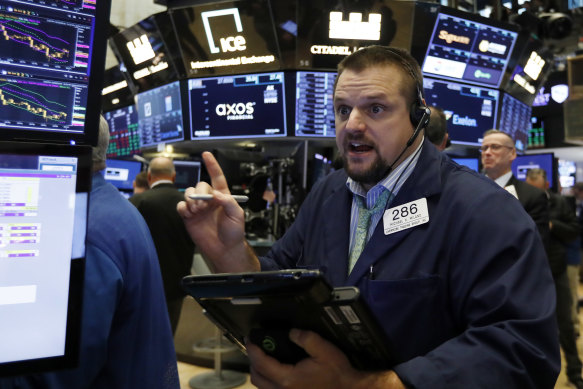Yields on 10-year bonds were touching 3.5 per cent in mid-June but have now fallen back below 2.8 per cent. The yields on two-year notes edged down but, at 3.21 per cent, the US yield curve is still inverted and still signaling, if not a recession, then a continuing slowing of activity.
The markets’ responses were driven by an optimistic assessment of the implications of the data for future US rate rises. The odds of the Fed raising its federal funds rate by a third consecutive 75 basis points next month lengthened and the likelihood of the next few increases being a less-confronting 50 basis points shortened.

Wall Street surged higher on the report.Credit:AP
Fed officials, however, have remained quite hawkish, perhaps because they don’t want to risk reversing the recent decline in US consumer and business expectations of future inflation. Whether it’s 75 basis points in September or 50 basis points, the messaging from the Fed is that there will be more rates rises in the US this year and into the early months of next year at least.
The slight cooling of the red-hot inflation rate last month is a step in the right direction but inflation in the US, and elsewhere, remains intolerably high.
There are also early indications of wages increasing in a very tight US employment market – unemployment is only 3.5 per cent – which will make the Fed and other central banks facing very similar circumstances cautious about taking their feet off the brakes too soon.
The prospect of some tapering of the likely path of Fed rate rises led to a slight softening of the US dollar against other major currencies. The dollar has depreciated about 3 per cent against the basket of its major trading partners in the past month – and almost five per cent against the Australian dollar – as interest rate differentials have started to close.
While the apparent peaking of the US inflation rate professes hope that the Fed and its peers elsewhere might be able to engineer “softish” landings for their economies, there is no guarantee that they can finesse their monetary policies to achieve best-case outcomes.
That will come as a relief to other central banks, including the Reserve Bank, worried about capital outflows and imported inflation if the US dollar continued to strengthen. The relationship between the Australian and US dollars is a key influence on the RBA’s monetary policies.
The caveats within any assessment of inflation rates is the geopolitical turbulence. The war in Ukraine has caused an energy crisis in Europe that, with the northern winter approaching, can’t be completely resolved and which is having international spillover effects, particularly on the LNG market.
The proposed US and European-imposed price caps on Russian oil exports could lead to Russia simply withdrawing its oil from the international market. Oil and petrol prices would then dream again.
China’s saber rattling in the Taiwan Strait could disrupt international shipping and add to the shortfalls in the global supply of semiconductors that have plagued industrial production generally, and globally, since the onset of the pandemic. Taiwan is a key global manufacturer of chips.

There are signs that the global supply chain dysfunction that has been a key driver in global inflation rates rising to levels not seen in decades is easing.Credit:Bloomberg
Those are just some of the obvious things that could adversely impact inflation rates and undermine the increased optimism in financial markets.
While the apparent peaking of the US inflation rate professes hope that the Fed and its peers elsewhere might be able to engineer “softish” landings for their economies, there is no guarantee that they can finesse their monetary policies to achieve best-case outcomes.
loading
Given that most of the major central banks target inflation rates of between two and three per cent there’s a long way to go, and many more central bank rate hikes, before success, if achieved, could be declared and a lot of potential for policy mistakes in either direction.
However, any reduction in what had been rapidly swelling US inflation is better than the alternative, and not just for America and Americans given the influence of US financial settings and markets on the rest of the world.
The Business Briefing newsletter delivers major stories, exclusive coverage and expert opinion. Sign up to get it every weekday morning.
